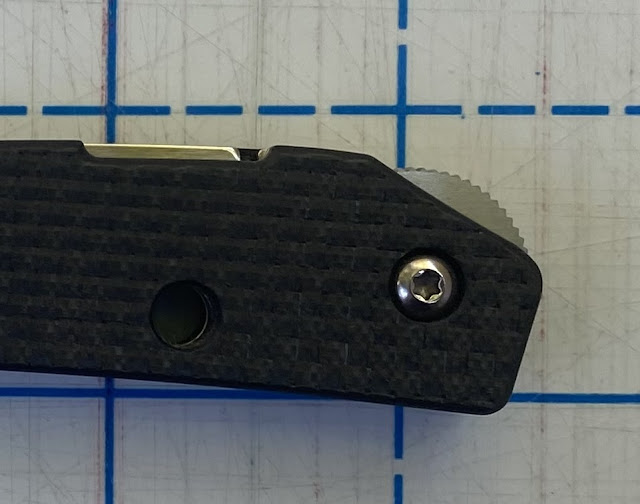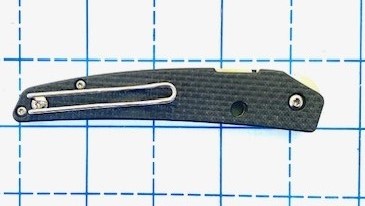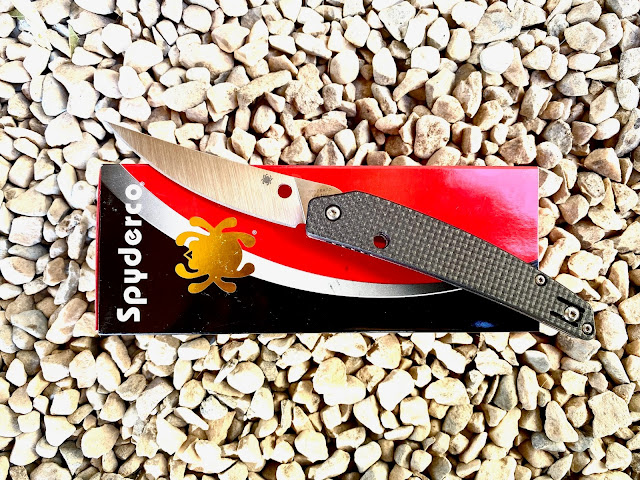I have a weakness for slim, lightweight pocket knives. Too many knives are overly thick and weighty making them, in my opinion, too heavy and bulky for everyday carry. Particularly for carrying in an office environment, which I do. My usual task for using a knife at work is opening food packages at lunch before throwing them in the microwave in our break room. But I've found that my larger pocket knives have blades big enough to make co-workers nervous when I've flipped them open. So I generally carry a smaller knife. Because I like the thumb-holes on Spyderco knives, I have mostly stuck to Spyderco knives over the years, having a couple myself and giving several to family members as gifts.
Earlier this year, I had gone into a knife store to one of my pocket knives (a Spyderco Watu) sharpened, and while my wife was talking to proprietor, I decided to look through the cases, and the Ikuchi knife pictured above caught my interest. I was taken by its small size, even thought it still sported a fairly long blade (3.26 inches) for a pocket knife. Since my Watu was going to be at the shop for about a week, I decided it was a good time to pick up an alternative. (Note: I didn't pay anywhere near the MSRP for either the Watu or the Ikuchi).
 |
| Each square is one inch. |
I've now used the Ikuchi off and on for about 6 months, so I think I have a good idea of its pluses and minuses. But, first, the statistics according to Spyderco:
Overall length (with the blade open): 7.61 inches/193 mm
Length (blade closed): 4.35 inches/110 mm
Blade length: 3.26 inches/83 mm
Cutting edge length: 3.18 inches/81 mm
Weight: 2.4 oz/68 grams
The handle is a carbon fiber/G-10 composite and feels very good in the hand, while keeping the overall weight down and the handle thin. The blade was wicked sharp (and at only 0.098 inches/2.5 mm thick at the spine, it is easy to sharpen to a very fine edge) and very pointy.
 |
| Each square is one inch. |
Although it retains Spyderco's trademark hole in the blade, it is pretty much cosmetic. Rather, there is a bit of a "hump" to the back of the blade that protrudes past the handle when closed with jimping on it that you can use to flip it open with a forefinger. I still have issues with this, so I have, on occasion, wound up using my thumb against the hole to finish opening the blade so it locks open.
 |
| This close up shows the hump with the jimping that you use to flip the blade open. |
Speaking of which, the lock is Spyderco's Compression Lock system, which is basically a liner lock, except on the top of the handle (and, thus, under the thumb or hand rather than the fingers).
 |
| Each square is one inch. The clip can also be switched to the other side for lefties. |
It uses a wire pocket clip that sits very high on the back of the handle so that the knife really does disappear deep into the pocket.
So, let's go over what I like about the knife. First, as I hope I've made clear, is that it is a very light and thin knife which, combined with the clip, makes it very nice for carrying unobtrusively in a business environment or if you just don't want something weighing down your pocket. It is well built and my experience with the lock, both with this knife and the Watu, is that it is very strong and secure. I know that cheap liner locks have a bad reputation, but this is very secure. And, being on the back of the knife, I think it safer to disengage the knife and close it one-handed than if the lock had been at the bottom edge of the handle. I also like the look of the knife.
The curved blade appealed to me because of the longer cutting edge and the idea that it would perform well in a draw cut. And it cuts well ... as long as you remember to draw it when cutting. That makes it great for opening food packages, but less useful for opening boxes. It works well for cutting food, however (like if you don't have a steak knife or get one of the extremely dull ones typical of most eating establishments).
Now, what I don't like: opening the knife. While it isn't hard to open, the smallish hump and jimping does not give you the leverage you would have with a flipper, like CRKT uses on many of its pocket knives. This is particularly apparent if your hand is wet and a bit slippery. Also, because you press your forefinger down on the jimping and then quickly bend or draw back your finger to flip the blade open, it is easier to flub the opening. Fortunately, the bit of the hole on the blade allows you to use your thumb to finish the opening movement if that happens. But it would have been a better knife if it had used a flipper.
The consequence is that after carrying it for a couple weeks straight, I found myself going back to my Watu knife for most everyday carry during the work week and only occasionally (maybe once or twice per week) carrying the Ikuchi. What brings me back to the Ikuchi is the size--the narrow handle with a relatively long blade--and the elegant look.

No comments:
Post a Comment